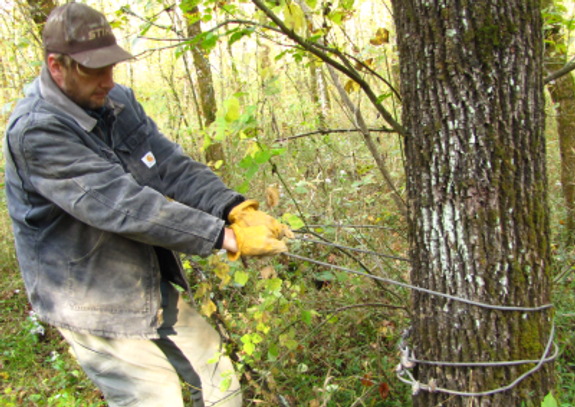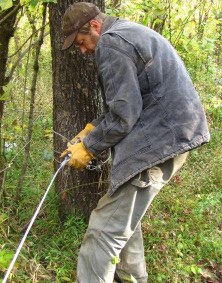
Securing a Super Winch cable to a tree


It's possible to wrap the Super
Winch cable around a tree and hook it onto itself. The instructions
clearly say to not do this.
I'm guessing it's because the
cable could get damaged.
We had a heavy chain for
wrapping around trees, but it somehow got lost it in the weeds a few
years ago. Now we use a cable with hooks on each end or a heavy duty
nylon tow strap depending on the situation.
Want more in-depth information? Browse through our books.
Or explore more posts by date or by subject.
About us: Anna Hess and Mark Hamilton spent over a decade living self-sufficiently in the mountains of Virginia before moving north to start over from scratch in the foothills of Ohio. They've experimented with permaculture, no-till gardening, trailersteading, home-based microbusinesses and much more, writing about their adventures in both blogs and books.
Want to be notified when new comments are posted on this page? Click on the RSS button after you add a comment to subscribe to the comment feed, or simply check the box beside "email replies to me" while writing your comment.

Mark, Whenever you use a cable for heavy pulling, you should take care not to cross over itself. Instead of linear contact (like a tourniquet), a crossed cable has point contact (more like scissors, which could either cut or weaken the cable). If you use the barber pole approach spiraling up and around the tree, I don't forsee any issues.
david
If I remember right, we know right where our chain is. We just can't find it! The thing is, we used it to winch a neighbor out who got stuck trying to drive back into our property, and before we could go to retrieve the chain, a flood came and washed through our driveway area. When the waters receded, the chain was no longer visible. Maybe with a metal detector we could find it --- I can't imagine the waters washed it too far....
Seems like we should have painted it neon orange....
David's comment is a good point. But there is another related issue.
If you wrap a steel wire around an object with a radius not much larger than the diameter of the wire, you will strain the outsides of the wire very much. Let the diameter of the wire be "d", and the radius around which it is wrapped "R", then the maximal elongation or compression in the bend equals d/(2R+d)×100%. So if you wrap 1/4" wire around a hook with a radius of 1/4" (1/2" diameter), you'll get an elongation of 33%. This is more than the yield elongation of a lot of kinds of steel. (Note that the angle between the in- and outgoing ends of the cable doesn't matter).
Now it is true that your cable isn't a single strand of steel but rather a rope twisted from several strands of thin wire. That is because that allows the strands to move with respect to each other. And it makes the strands act like a coiled spring. This allows a rope a smaller bend radius than a wire. But the principle remains.
Making a sharp bend in a rope or wire can cause irreversible damage. The same goes for the point-to-point contact of crossing wires. The first sings of both will be a kink in the cable.
Yes, but that is only part of it. What David points out is valid as well.
By overwrapping you also get what is called point contact between the wires. Imagine two cylinders with their lengths perpendicular to each other. Now press them together. With perfect cylinders they would only contact each other in a mathematical point. The engineering term stress is defined as units of force per unit of area. If you only have a miniscule contact area, even a small force would result in a large stress. In a mathematical point with zero surface area, you'd get infinite stress. In practice the contact surfaces will deform, reducing the stress.
Consider a knife. It also concentrates the force that you press it down with on the tiny surface of it's edge. That is in essence what makes it cut.
Of course twined ropes will not have a single contact spot but a couple of them because of their surface geometry. But the principle remains the same. Two overwrapped wires under tension are essentially cutting into each other.
What you need to get is a tree strap. It also goes by a tree saver. It's a length of wide nylon strapping with eyelets on each end. I wraps around the tree and is secured to your winch line's hook through the eyelets. It distributes the pulling load over a wider surface which helps protect the tree as well as your winch line. Also to lighten the weight of your winch you can look into nylon winch line. It's a special rope cable that is super light but still have the pulling capacity of a steel cable of larger size and weight.